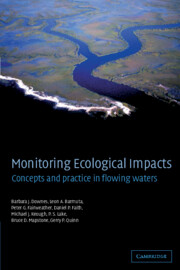Book contents
- Frontmatter
- Contents
- Preface and Acknowledgements
- Part I Introduction to the nature of monitoring problems and to rivers
- Part II Principles of inference and design
- Part III Applying principles of inference and design
- 8 Applying monitoring designs to flowing waters
- 9 Inferential uncertainty and multiple lines of evidence
- 10 Variables that are used for monitoring in flowing waters
- 11 Defining important changes
- 12 Decisions and trade-offs
- 13 Optimization
- 14 The special case of monitoring attempts at restoration
- 15 What's next?
- References
- Index
10 - Variables that are used for monitoring in flowing waters
Published online by Cambridge University Press: 21 August 2009
- Frontmatter
- Contents
- Preface and Acknowledgements
- Part I Introduction to the nature of monitoring problems and to rivers
- Part II Principles of inference and design
- Part III Applying principles of inference and design
- 8 Applying monitoring designs to flowing waters
- 9 Inferential uncertainty and multiple lines of evidence
- 10 Variables that are used for monitoring in flowing waters
- 11 Defining important changes
- 12 Decisions and trade-offs
- 13 Optimization
- 14 The special case of monitoring attempts at restoration
- 15 What's next?
- References
- Index
Summary
From the previous chapter, it should be apparent that choice of variables to use in a monitoring program is a critical decision and not one to make arbitrarily or hastily. However, many biomonitoring texts (e.g. Davis & Simon 1995; Karr & Chu 1999; Rosenberg & Resh 1993) focus upon only particular taxonomic groups or particular kinds of variables. Specific biomonitoring studies are spread over many different journals, from those specializing in particular taxa to ones on whole communities, and from those publishing mainly in areas of basic ecology to those directed specifically at applied ecology or environmental management. It is difficult for any individual to keep track of all of this literature, and researchers can often be unaware of developments outside their immediate field of expertise.
Here, we summarize briefly the characteristics of useful variables. Although much of this material is discussed in other chapters (chapters 6, 9 and 11), we summarize it here simply to emphasize that useful monitoring variables are not necessarily associated with particular taxonomic groups and that researchers are advised to look widely across the taxonomic and ecological range. From chapter 9, it should be clear that dogmatic advice about which taxa should be monitored should be avoided. Although this may disappoint those who prefer simple recipes, choice of response variables requires measured consideration of a number of attributes.
- Type
- Chapter
- Information
- Monitoring Ecological ImpactsConcepts and Practice in Flowing Waters, pp. 289 - 305Publisher: Cambridge University PressPrint publication year: 2002



